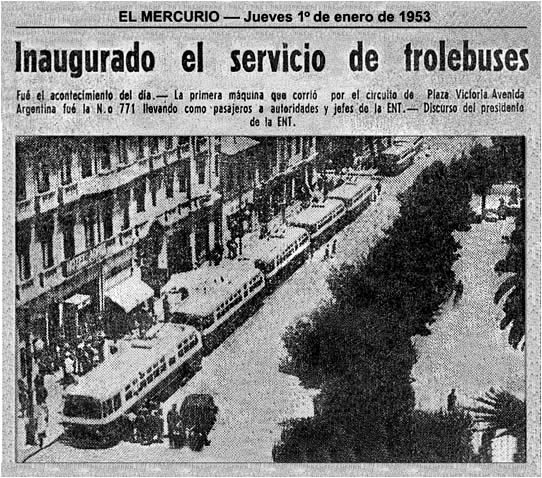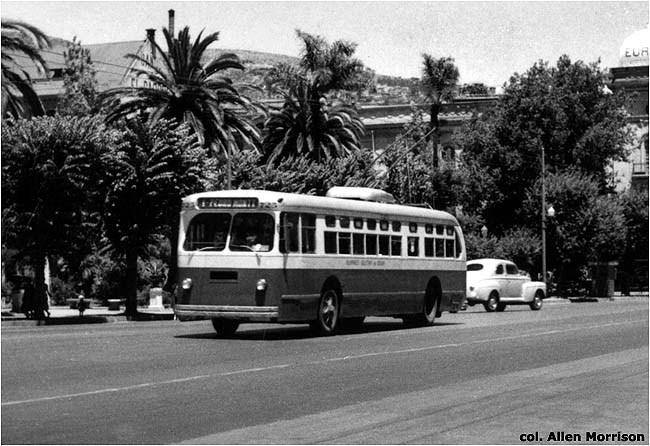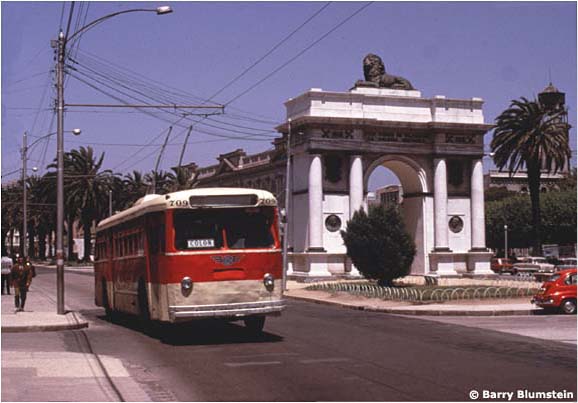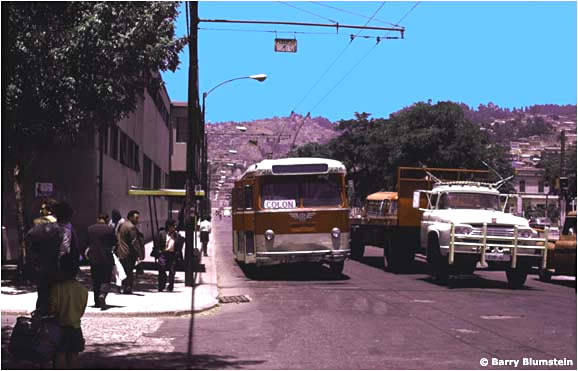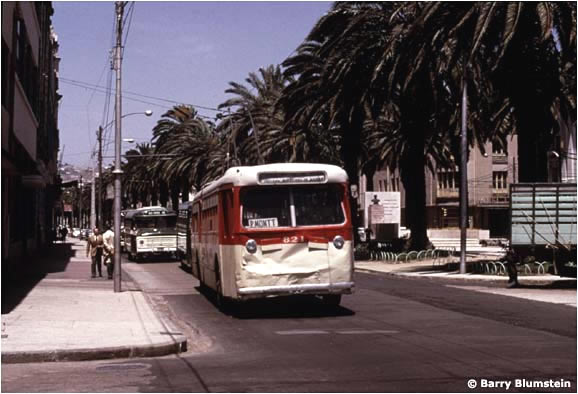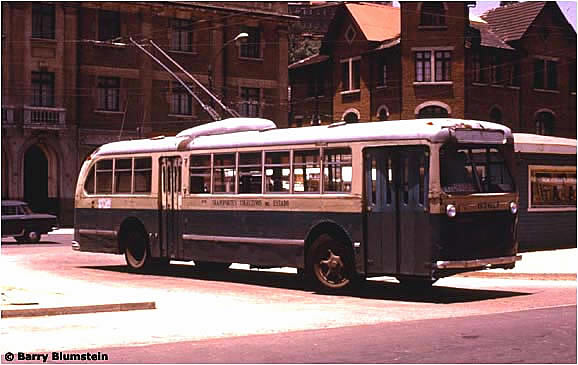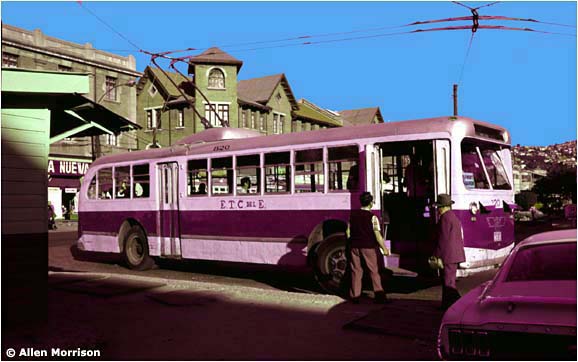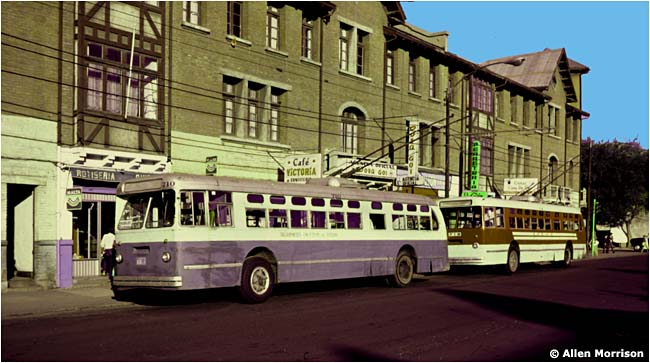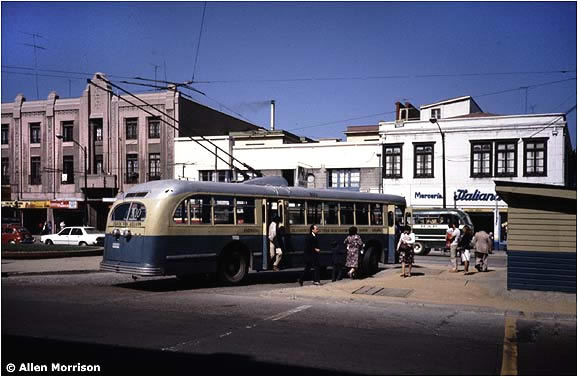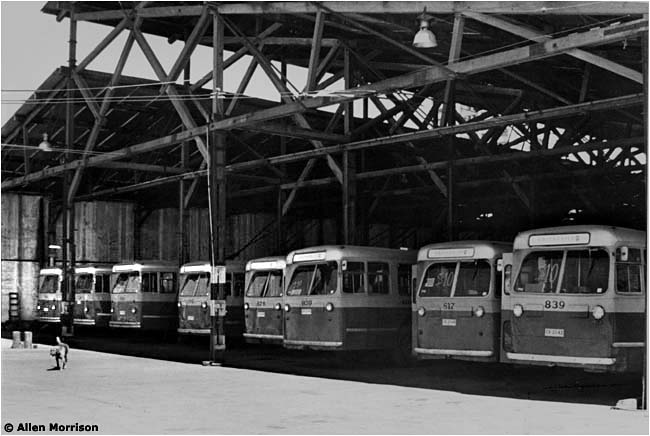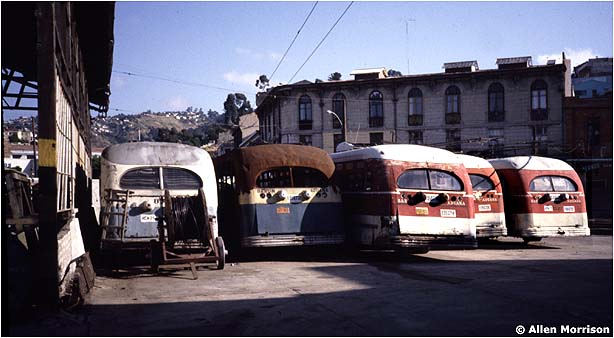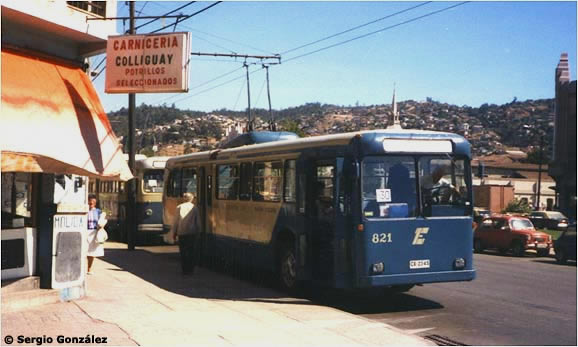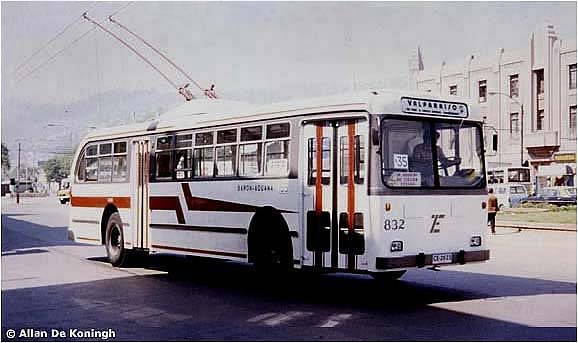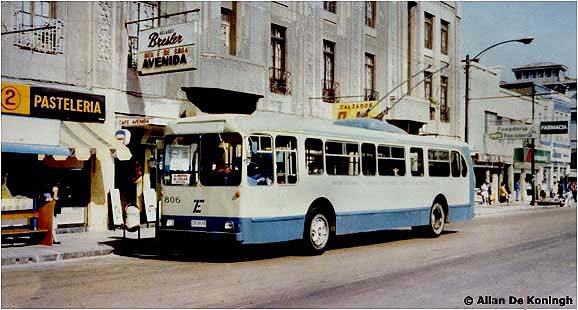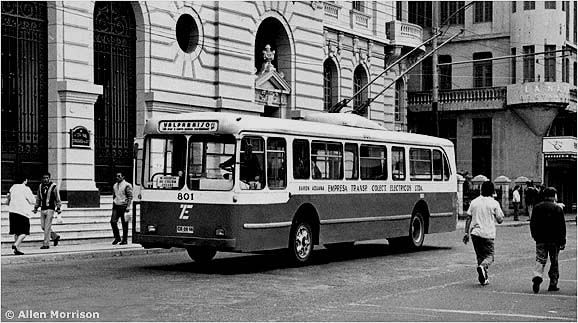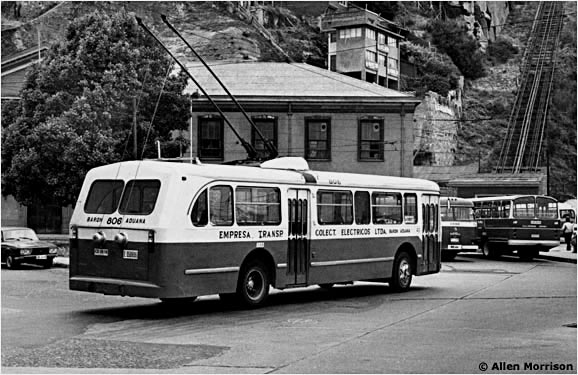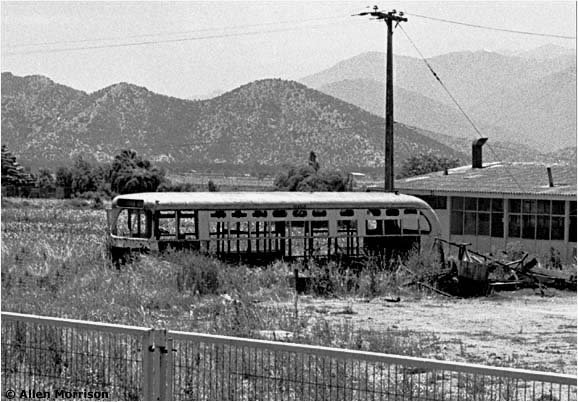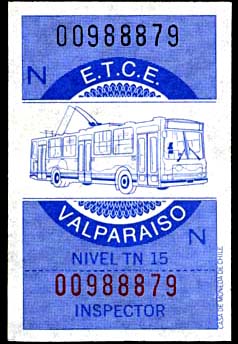The Trolleybuses of BY
The Valparaíso-Viña del Mar conurbation, on the Pacific coast 100 km west of Santiago, is the second largest in Chile and has about a million residents. The historic city of Valparaíso, Chile's chief port, sprawls around a bay surrounded by steep hills [see map]. The latter are scaled by twisting roads, a 60-meter-high, 3-station elevator and 15 funicular railways. Viña del Mar, by contrast, is flat, is Chile's chief tourist resort, and is more populous today. The railroad that opened in 1855 between Barón station in Valparaíso and El Salto near Viña del Mar still runs today and is the oldest continually operating railroad in the southern hemisphere [see map]. It was not extended to its present terminus at Puerto station until 1875. In 1863, to connect Barón with the port area and Aduana (Customs House) on Plaza Wheelwright, a local banker built one of South America's first horsedrawn street railways. "Barón - Aduana" was also the route of the city's first electric tram line in 1904 and its first electric bus line in 1952. Part A: 1952-1989 Chile's trolleybus era began in 1945 when the foreign-owned transport companies in Santiago and Valparaíso were expropriated by the federal government. The new Empresa Nacional de Transportes decided to eliminate trams from both cities and, as a first step, ordered 30 trolleybuses from Pullman Standard Corporation in Worcester, Massachusetts, USA. Fifteen would run in Santiago. The other fifteen would replace trams on the 10-km coastal line between Valparaíso and Viña del Mar [see map]. ENT ordered more trolleybuses from Pullman in 1946 and the first six vehicles, numbered 801-806, arrived at the port of Valparaíso in early 1947. One of them was displayed on Plaza Sotomayor on 26 February. Those six vehicles and other 800s that arrived soon after were transported to Santiago where they inaugurated the capital's first trolleybus line the following 31 October [see Santiago page]. The Viña del Mar trams were replaced by gasoline buses. Valparaíso had to wait five more years for trolleybuses. In 1952 ENT ordered 30 trolleybuses from Pullman for its Valparaíso division (which, incidentally, were the last trolleybuses that Pullman built) and prepared its tram depot on Calle Independencia for rubber tires [see map]. Valparaíso's trolleybuses were of a later design and numbered 701-730 (its trams had been numbered through the 600s). The first three arrived on the docks on 2 November 1952 and seven trolleybuses inaugurated the city's first trolleybus line, along Av. Pedro Montt from Plaza Victoria to Plaza Barón, on Wednesday, New Year's Eve, 31 December 1952. The city's last tram ran the night before. The newspaper clipping below shows the lineup on Calle Molina the day of the inauguration [see map]. The text states that the parade was led by trolleybus 771, which is mystifying, since there was no vehicle with that number. Another photograph shows number 711 in front, so the reporter must have erred [col. Diego González Vargas]:
The line was extended from Plaza Victoria to Aduana on 7 January 1953 and a second route, from Barón to Aduana via Av. Colón, opened in February. ETCE announced plans for an extension to Playa Ancha [see map]. On 2 May 1953 ENT was reorganized as a new government agency, Empresa de Transportes Colectivos del Estado, which operated the trolleybus systems in both Santiago and Valparaíso from then on. The following view, from a postcard dated 5 March 1955, shows Pullman trolleybus 725 on Av. Pedro Montt. The inscription below its windows says "TRANSPORTES COLECTIVOS del ESTADO". This is the earliest known good photograph of a trolleybus in operation in Valparaíso [col. AM]:
By 1953 the Santiago system had a fleet of 200 trolleybuses. In 1954 ETCE transferred 39 of its 800 series to Valparaíso (allegedly numbers 801-839) to operate the suburban line to Viña del Mar that had been planned for 14 years. The new route ran from Aduana to Barón via Av. Brasil, then on Av. España along the coast to Viña del Mar [see map]. At Puente Capuchinos it split in two: one branch crossed the railroad and ran along Calles Viana and Quillota to 15 Norte; the other continued along Calle Álvarez to Chorrillos (duplicating the former tram line). A tram garage at Chorrillos was adapted for trolleybuses. A peculiarity of the Viña operation was the presence, for 2 km, of electric bus lines on both sides of the electrified railroad. There were at least ten overhead wires! On Monday 7 December 1959 ex-Santiago trolleybus 810 inaugurated the Quillota branch as far as Plaza Sucre in Viña del Mar. The route was completed to 15 Norte "soon after" (according to a newspaper). A year later, on 29 December 1960, trolleybuses 822 and 824 opened the other line to Chorrillos [see map]. But the two Viña lines lasted less than five years. A visitor found both closed in 1964. Some of the 800-series trolleybuses returned to Santiago in 1965. Not much else is known of trolleybus operation in Valparaíso in the 1950s and 60s. At some time during this period (date unknown) a line was built up the hill on Av. Washington to Barrio O'Higgins [see map]. Trolleybus 714 had no difficulty climbing the steep grade, but its brakes did not perform properly on the return, so the project was abandoned. After the military coup in 1973, the new Pinochet administration cut funding for government-run transport organizations and trolleybus systems in both Santiago and Valparaíso deteriorated rapidly. ETCE began to close its lines in Santiago and transferred some of its 800-series Pullmans to Valparaíso again. A visitor in December 1974 found trolleybuses running on only two routes in Valparaíso, from Barón to Aduana via Av. Pedro Montt, and from Barón to Aduana via Av. Colón. His first photograph shows trolleybus 709, one of the original vehicles from 1952, passing the Arco Británico on Av. Brasil [see map] [Barry Blumstein]:
The next view shows 726 traveling north on Av. Argentina, near Barón terminus [see map]. A little sign marked "PARADERO TROLEBUS" (trolleybus stop) hangs overhead [Barry Blumstein]:
(In 1977 a passenger and the driver were electrocuted on trolleybus 726.) 821, below, is a former Santiago trolleybus signed for Av. Pedro Montt. Interestingly, the destination marked in the box above the window is "ADUANA QUILLOTA 15 NORTE" (Viña del Mar) – where this vehicle could not have gone in 10 years! [Barry Blumstein]:
The last photograph from December 1974 shows a very decrepit 876 at Barón terminal loop [see map]. The inscription on the side reads "876 TRANSPORTES COLECTIVOS DEL ESTADO" [Barry Blumstein]:
After the Santiago system closed completely in 1978, ETCE transferred all its remaining trolleybuses to Valparaíso. Here is ex-Santiago trolleybus 820 at Barón terminal in April 1981 [AM]:
Valparaíso's 700 series trolleybuses continued in service, with new liveries – but otherwise looking very much as they looked 26 years before (compare first photograph on this page). Here are 710 and 716 on Av. Argentina in 1981 [see map] [AM]:
The Valparaíso trolleybus system, in turn, ceased operation on 30 November 1981 and the Empresa de Transportes Colectivos del Estado was dissolved. No trolleybuses ran in Valparaíso (or anywhere in Chile) for at least four months. On 26 April 1982 a group of Valparaíso businessmen acquired the assets of the former ETCE – vehicles, infrastructure and operating rights – and formed a new company, Empresa de Transportes Colectivos Eléctricos. The new ETCE restored its aging fleet, resumed operation and established a first-class transport service in the city. The photograph below shows ex-Santiago trolleybus 821 at Barón loop in November 1985. The inscription on the side of the vehicle is "EMPRESA TRANSPORTES COLECTIVOS ELECTRICOS / BARON ADUANA" [AM]:
A lineup at Estación Independencia in November 1985 [see map]. This was originally the tram depot built by the city's German tramway company, Elektrische Straßenbahn Valparaíso, in 1903 [see Valparaíso chapter of The Tramways of Chile]. 700 series trolleybuses are on the left, 800s on the right. Bumpers and headlight placement are the distinguishing features on the front [AM].
Surplus trolleybuses in the yard at Estación Independencia in 1985. The vehicles are 877, 722, 714, 729 and 723. The charred roof on 722 was the result of a student demonstration in 1984. Trolleybuses 729 and 723 were later rehabilitated; 723 still operates today [AM]:
In 1986 ETCE's versatile engineers and mechanics began a program of radical reconstruction. Eleven trolleybuses (801, 802, 804, 806, 818, 821, 822, 824, 832, 859 and 888) were remodeled. All emerged with new liveries, rectangular headlights and larger windows in the front. Most also had new windows on the sides and rear. The following photograph of 821 (also seen in previous pictures) was taken on Av. Argentina in February 1987 [Sergio González]:
832, below, was photographed on Av. Argentina in November 1988. It has a larger front window, but the side windows are unchanged. The message in the destination box is "VALPARAISO ¡de mar a cerro somos cordialidad!" (from sea to hill we are cordiality) [Allan De Koningh]:
806, built in 1946, was also photographed on Av. Argentina in 1988 [see map]. All its windows have been reshaped and enlarged. The new logo looks like "TE", but is actually a stylized "ETCE" [Allan De Koningh]:
Pullman 801, Chile's oldest trolleybus, was photographed on Plaza Sotomayor in 1989, by which time all the rebuilt trolleybuses had been repainted in ETCE's traditional cream and blue-green livery. Except for its colors, 801 is identical to 806 above [see map] [AM]:
Pullman 806, also seen in another photo, has new windows mounted at an angle on the back. It was approaching the old Aduana (Customs House) on Plaza Wheelwright in November 1989 [see map]. William Wheelwright was the Massachusetts industrialist who established Chile's first steamship lines in 1840 and its first railroad in 1851. The Artillería funicular on the right was built in 1893 [AM]:
Alas, not all trolleybuses were so lucky. The photograph below was taken in 1989 on the east side of highway 5 about 50 km south of Santiago. This is Valparaíso trolleybus 702 [AM]:
An ETCE ticket used during the 1980s. The trolleybus in the drawing is a Mafersa model used in São Paulo, Brazil.
BIBLIOGRAPHY "Se Aumentó a Cien la Compra de Trolebuses" in El Mercurio (Santiago), 16/11/1945, np. Long article says that 100 trolleybuses have been "acquired" in the U.S. for Santiago and Valparaíso. 30 are ready for shipment to Chile. 15 will run between Valparaíso and Viña del Mar. "Chilean Economic Review" in U.S. Department of Commerce, Internationonal Trade Office, International Reference Service, vol. 3, no. 59 (12/1946). "Street Railways" section describes trolleybus plans in Santiago and Valparaíso and purchase of 130 trolleybuses in the U.S. "Mañana se iniciaría el Servicio de Trolebuses" in La Unión (Valparaíso), 27/12/1952. The ENT says the line is ready, but the mayor objects to such a short route from Barón to Plaza Victoria. Trams will continue to run on Av. Pedro Montt until trolleybuses reach Plaza Sotomayor. "La inauguración oficial de los trolebuses ha sido suspendida" in La Unión (Valparaíso), 28/12/1952. Inauguration postponed because ENT officials don't want to leave their families in Santiago during the holidays . . . Trolleybuses will make test runs today. Mayor approves the short route to Plaza Victoria, but sets no date for the inauguration. "Primer trolebús averiado" in La Unión (Valparaíso), 25/1/1953. First trolleybus accident. Driver loses control and crashes 706 into a post on Calle Prat. "Iniciarán extensión de línea de trolebuses hasta Playa Ancha" in La Unión (Valparaíso), 5/2/1953. Government increases financing so that ENT can increase power and place eight trolleybuses in service on the new route on Av. Colón. Construction will begin on an extension from Aduana to Playa Ancha. Ramón Lira Lira. Los Viejos Tranvías Se Van. Santiago, 1955. Large 768-page transport history describes the closure of the tramway system and the inauguration of the first trolleybus line, pp. 750-756. Joris Ivens, director. "A Valparaíso" (In Valparaíso), France, 1962. A scene in the film shows trolleybus 716 signed "15 Norte", indicating that the Viña lines were not served exclusively by 800-series trolleybuses. Allen Morrison. "The Trolleybuses of Valparaíso, Chile" in Trolleybus Magazine (London) #147, 5-6/1986, pp. 50-55. History, two maps, five photographs. Additional comments by Steve Morgan. "Trolebuses no dejarán Valparaíso" in El Mercurio (Valparaíso), 10/7/1987. Reconstruction of 15 trolleybuses for the new line in Santiago. Assurances that trolleys will continue to run in Valparaíso. "Perduran trolebuses" in El Mercurio (Valparaíso), 11/7/1987. Good, positive history of trams and trolleybuses in Valparaíso. The author says that the city needs both forms of transportation. "De los caballos a los trolebuses" in El Mercurio (Valparaíso), 3/12/1987. General trolleybus history and plans to install them in "otros puntos del país" (other parts of the country), including Santiago. Guillermo Arrieta Muñoz. "Ir y venir de los trolebuses" in El Mercurio (Valparaíso), 16/5/1989. Brief history of the city's trolleybuses. "USM: Estudian construcción y adaptación de trolebuses" in El Mercurio (Valparaíso), 22/5/1989. Engineers at the Universidad Santa María propose the modernization and expansion of the city's trolleybus system and the creation of a new trolleybus industry in Chile. Adrián González. "Elefantes Con Suspensores" in El Mercurio (Santiago), 23/9/1998. Excellent survey of trolleybus development in Chile. Notes on the route to Barrio O'Higgins and the fatalities on trolleybus 726 in 1977. Alvaro Rojas R. Mucho Trolley: Los Trolebuses de Valparaíso, Chile. The "Historia" section details trolleybus development in Chile. This page is dedicated to the memory of Sergio González Pavesio of Viña del Mar, who among many favors supplied most of the articles noted above. The author would also like to thank Barry Blumstein of Hobart, Tasmania, for photographing Chilean trolleybuses in 1974; the extraordinary crew of ETCE mechanics who have maintained the vehicles so heroically and expertly for so many years; Diego González Vargas and Sebastián López in Santiago; and Steve Morgan in Portland, Oregon, USA, who provided valuable historical information. Go to Ver versión en español de esta página Also see my page devoted to See my index of If you have comments, criticism or suggestions, This site was placed online on Copyright © 2006-2106 Allen Morrison |
|
